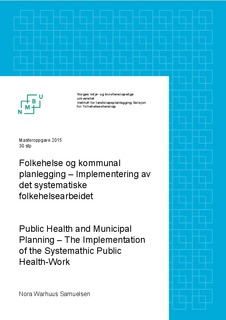| dc.contributor.author | Samuelsen, Nora Warhuus | |
| dc.date.accessioned | 2015-07-28T10:04:40Z | |
| dc.date.available | 2015-07-28T10:04:40Z | |
| dc.date.copyright | 2015 | |
| dc.date.issued | 2015-07-28 | |
| dc.identifier.uri | http://hdl.handle.net/11250/293731 | |
| dc.description.abstract | Folkehelseloven fra 2011 bygger på tankegangen fra WHO om en utvidet og helhetlig forståelse av helse. Loven introduserer det systematiske folkehelsearbeidet som en arbeidsprosess for å koble folkehelse og planlegging i kommunene. Informasjon om befolkningens helsetilstand og påvirkningsfaktorer skal være grunnlag for den videre planprosessen i kommunen. Dette representerer en ny måte å tenke planlegging på i kommunen.
Formålet med oppgaven er å undersøke hvordan møtet mellom folkehelse og planlegging gjennom det systematiske folkehelsearbeidet oppleves og oversettes i kommunen. Hovedproblemstilling for oppgaven er: Hva er mulighetene og begrensningene knyttet til implementering av det systematiske folkehelsearbeidet?
Designet for oppgaven er casestudie av to ”gjengse” norske kommuner. Metodene brukt for innsamling av data er kvalitative intervjuer av kommuneansatte og analyse av dokumenter som er relevante i det systematiske folkehelsearbeidet.
Funnene i oppgaven viser at det eksisterer ulike forståelser av folkehelse innad i kommunen og dette gjør det vanskelig å oversette og operasjonalisere folkehelsearbeidet. Den tydelige koblingen mellom folkehelse og planlegging har satt folkehelse på planagendaen, men det er en utfordring å få politikerne til å prioritere det langsiktige folkehelsearbeidet. Trang kommuneøkonomi hindrer også en styrking av folkehelsearbeidet. Fysisk aktivitet er et tema som er godt implementert i kommuneplanene, mens tema sosiale helseforskjeller er mer utfordrende å oversette i plansammenheng og er i mindre grad integrert. Kommunene har ikke utarbeidet et oversiktsdokumentet over befolkningens helsetilstand og påvirkningsfaktorer.
De to kommunene undersøkt har økt bevisstheten rundt folkehelse i planleggingen, samtidig finner de denne nye tankegangen krevende å oversette og implementere i kommunen som organisasjon.
The Public Health Law of 2011 is based on WHO ́s perspective of an expanded and comprehensive understanding of health. The law introduces the systematic public health-work as a working-process for connecting public health and planning in municipalities. According to this working-process information about the health of the population and health-influencing factors should be the foundation for the planning process. This represents a new approach in municipal planning.
The purpose of the study is to examine how municipalities perceive and translate the connecting of public health and planning introduced through the systematic public health- work. The following research question is examined: What are the opportunities and limitations related to the implementation of the systematic public health-work?
This is explored through a case study of two "average" Norwegian municipalities. The methods used for collecting data are qualitative interviews with municipal employees and analysis of documents relevant to the systematic public health-work.
The findings show that there are different understandings of public health within the municipality that makes the translation and operationalization the public health work challenging. The focus on connecting health and planning has put public health on the planning agenda. Still, the municipalities struggle to make politicians prioritize the long-term public health work. Poor municipal economy also prevents a strengthening of the public health-work. Physical activity is a topic that is well implemented in the municipal plans, whereas the theme social inequities in health is more challenging to translate into planning and is therefore less integrated. The municipalities have not yet conducted an overview document on the population's health-status and health-influencing factors.
The two municipalities have an increased awareness of public health in planning, at the same time they find this new mindset difficult to translate and implement the municipality as an organization. | nb_NO |
| dc.language.iso | nob | nb_NO |
| dc.publisher | Norwegian University of Life Sciences, Ås | |
| dc.subject | folkehelse | nb_NO |
| dc.subject | kommunal planlegging | nb_NO |
| dc.subject | samfunnsplanlegging | nb_NO |
| dc.subject | casestudie | nb_NO |
| dc.subject | det systematiske folkehelsarbeidet | nb_NO |
| dc.subject | folkehelseloven | nb_NO |
| dc.title | Folkehelse og kommunal planlegging : implementering av det systematiske folkehelsearbeidet | nb_NO |
| dc.title.alternative | Public Health and Municipal Planning – The Implementation of the Systemathic Public Health-Work | nb_NO |
| dc.type | Master thesis | nb_NO |
| dc.subject.nsi | VDP::Social science: 200 | nb_NO |
| dc.subject.nsi | VDP::Medical disciplines: 700::Health sciences: 800 | nb_NO |
| dc.source.pagenumber | 88 | nb_NO |
| dc.description.localcode | M-FOL | nb_NO |
